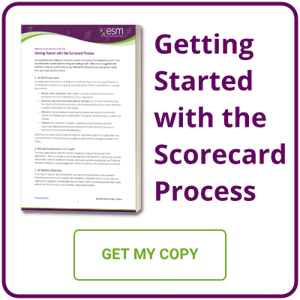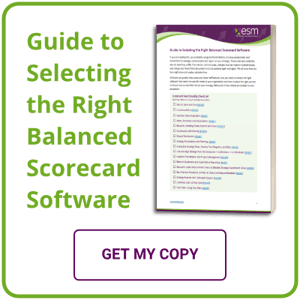Having a strong loss prevention program is essential for any retail organization. Loss and shrinkage can have a major impact on profits, customer satisfaction, and employee morale. According to a CNBC interview with Chief Financial Officer, Michael Fiddelke, Target saw a 50% year over year increase in shoplifting from 2021 to 2022, resulting in over $400 million negative impact on Target’s margins. A similar sentiment was expressed by Walmart CEO, Doug McMillon, which could result in higher prices and potential store closures.
Having the right tools to track, monitor, and report on the metrics associated with your loss prevention program is key to optimizing your efforts. Scorecards are a powerful tool that can help you optimize your program and ensure that your retail organization is successful.
Getting started can feel overwhelming, but it doesn’t have to be. Below is a list of key steps to get your loss prevention scorecard up and running.
1. Set Goals for Loss Prevention for your Organization
Start by gaining a clear understanding of your company’s overall core strategic objectives and determine specifically how your loss prevention team can help your company reach those goals. It may help to group your loss prevention goals from the following perspectives: Prevention, Awareness, Compliance, Detection, Investigation and Resolution. If your company is striving to improve overall profitability then you may want to set a goal to reduce losses due to theft and  shrinkage by 10% year-over-year. For employee satisfaction, you may want to set a goal of improving employee satisfaction with loss prevention awareness efforts by 8% year-over-year. For customer satisfaction, you may want to set a goal of increasing customer loyalty by 8% year-over-year.
shrinkage by 10% year-over-year. For employee satisfaction, you may want to set a goal of improving employee satisfaction with loss prevention awareness efforts by 8% year-over-year. For customer satisfaction, you may want to set a goal of increasing customer loyalty by 8% year-over-year.
Whatever your ultimate loss prevention goals are, be sure to align your team goals with the goals for your organization at large. A loss prevention strategy must not be built in isolation. This is extremely important, as gaining executive buy-in is critical especially when asking for additional resources and budget required to achieve your loss prevention goals.
2. Identify Performance Metrics
Once you create and align your goals, it’s time define metrics that clearly demonstrate if you’re achieving your objectives and desired outcomes. This is a very important step, as the metrics you choose will empower your team to make decisions and take actions so that you can move the needle on overall performance.
While loss prevention is a common function, the specific needs and challenges your organization faces are likely going to be a little different. Regardless, metrics such as theft rates, customer satisfaction levels, employee satisfaction levels are probably part of the mix. Additionally, you may want to track metrics such as inventory accuracy, % of damaged goods, % of goods overstocked, and pricing errors, as these can also lead to losses. While being comprehensive is important, try to resist the urge to measure everything. If you pick too much to track, real insights could get lost in the noise and may not be worth the effort to capture. Focus your team and your leadership team on the critical few metrics that tell 90% of the story.
3. Implement a Tool to Standardize Management and Execution of the Loss Prevention Program
Once you’ve identified the goals and set metrics, you should implement a scorecard solution that enables you to track, monitor, and analyze your objectives, performance metrics and projects designed to close any gaps. While spreadsheets are a common way to get started with building scorecards for your loss prevention program, this approach has many limitations.
 Ideally, you will advance to a cloud-based solution that can be accessed by multiple users, that is easy to use, and empowers you to seamlessly collect data from multiple people across the organization. This solution should synthesize the aggregated data into useful information and empower you to create customized views of the data using simple drag-and-drop dashboards that can be shared with key stakeholders who ultimately will drive actions that help your organization minimize loss.
Ideally, you will advance to a cloud-based solution that can be accessed by multiple users, that is easy to use, and empowers you to seamlessly collect data from multiple people across the organization. This solution should synthesize the aggregated data into useful information and empower you to create customized views of the data using simple drag-and-drop dashboards that can be shared with key stakeholders who ultimately will drive actions that help your organization minimize loss.
4. Monitor and Review Results Regularly (At Least Monthly or Quarterly)
In order to understand when course correction is required, you will need to establish a cadence to regularly monitor the results of your loss prevention program. Be sure to establish a governance calendar with recurring data collection, analysis, report generation and leadership reviews. Standardize the specific information you collect as well as who will be responsible for gathering the information. Set deadlines for team members to prepare monthly/quarterly performance analysis and recommendations for improvement to the program. This will ensure that you’re consistently measuring what matters most and acting on it in a timely manner.
Once the analysis is prepared, you should coordinate meetings with key stakeholders including what and why something happened as well as recommendations for management to consider to address any gaps in your program. Leadership reviews should be decision making meetings and action item-focused based on the recommendations provided.
5. Analyze Data
Data analysis will help you determine if your loss prevention program is generating the desired results. This includes evaluating your program goals to see if you are achieving them, if you are hitting targets for key success metrics, and if you are making progress on the projects that your team is pursuing to minimize your losses. Set up recurring auto report generation and distribution to easily disseminate timely information across the organization and support data analysis.
Regular evaluation of the loss prevention scorecard will help you identify areas for improvement so you can adjust your program accordingly. For example, if theft rates are higher than your targeted amount or more than benchmarks for like retailers in your industry, you may need to modify or implement new loss prevention initiatives.
Having a one-stop-shop to house your loss prevention program objectives, measures of success and projects designed to close the gaps will make it easy for you to analyze the data that matters most to your business.
6. Take Action
Once you’ve established a cadence to analyze data from your loss prevention scorecard, you will be in a position of confidence, ready to take action to ensure that your loss prevention program is as effective and efficient as possible. This may include making changes to the program, implementing new initiatives, or training employees to better recognize and respond to potential threats.
Summary
Establishing a strong loss prevention program is essential for any retailer and a reliable scorecard solution is key to optimizing your efforts and ensuring success. The solution can help you set goals and identify performance metrics, track and monitor your program, review results regularly, and take action to ensure your program is effective and efficient. By implementing a scorecard solution, you can easily collect data from multiple people, synthesize the aggregated data into useful information, and create customized views of the data with simple drag-and-drop dashboards that facilitate decision making and action. With the right tools in place, you’ll be one step closer to establishing a repeatable loss prevention program that evolves with the ever-changing needs of the retail industry.






